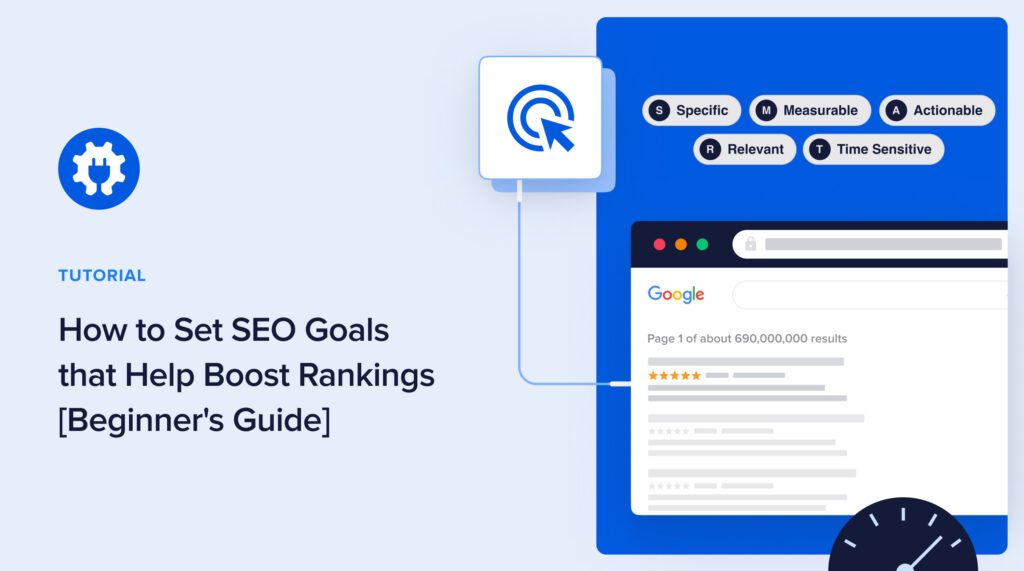Would you like to know how to set SEO goals that result in better rankings?
Setting goals for your SEO campaigns helps you know what you’re working towards and gives you a clear direction on the steps to take.
In this article, we’ll show you how to set meaningful SEO goals to help you drive your business forward.
In This Article
What are SEO Goals?
SEO goals are objectives you aim to achieve through your SEO campaigns over a period of time. Each goal should contribute to the overall purpose of your SEO and help you reach your business goals.
In short, your SEO goals should help you reach more prospective users through organic search. Your SEO goals should also help you turn website visitors into customers or subscribers.
Is Setting SEO Goals Important?
Setting SEO goals is important as it helps focus on the necessary SEO tasks that get you results. It also helps bring clarity to your campaign. This way, everything you do is bound to produce better results.
Running your SEO campaigns without any goals is like shooting in the dark. You don’t know what you’ll hit. And even if you hit something, it may not be the result you’re looking for.
So, to run impactful SEO campaigns, you should set common-sense SEO goals.
How to Set SEO Goals in 5 Easy Steps
Ready to set impactful SEO goals? Let’s dig into some tips.
1. Have the Right SEO Tools
One of the first steps to succeeding in setting and achieving your SEO goals is to have the right tools. And one of the best and most versatile SEO tools is All In One SEO (AIOSEO).
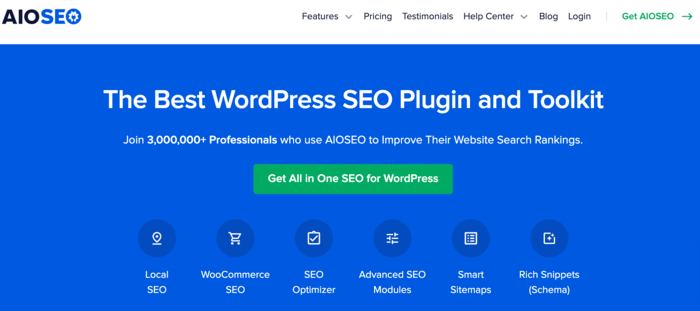
AIOSEO is the best WordPress SEO plugin on the market and has been downloaded over 100 million times. Millions of savvy website owners and marketers trust the plugin to help them dominate search engine results pages (SERPs) and drive relevant traffic to their sites. This plugin has many powerful SEO features and modules to help you optimize your website for search engines and users.
When setting and monitoring your SEO goals, AIOSEO has features like SEO Analysis and Search Statistics to help you get the essential data you need to run impactful campaigns.
For step-by-step instructions on how to install AIOSEO, check out our installation guide.
2. Be S.M.A.R.T
One of the first steps to setting common-sense SEO goals is to be S.M.A.R.T. This means when you set your SEO goals, they should be:
- Specific: Your SEO goals must be specific, not generic. It helps you prove that your optimization efforts are working.
- Measurable: You should be able to assign key performance indicators (KPIs) to your goals.
- Actionable: Ensure you can take actionable steps that can impact the KPIs.
- Relevant: Every SEO goal should be relevant to your marketing and business objectives.
- Time-bound: Include time-related parameters to help you keep track of your progress.
Knowing how to set S.M.A.R.T. SEO goals is critical to running successful campaigns. It helps you manage expectations and be in control of your progress.
3. Start with the Outcome
Consider your outcome as the endgame: what you want to achieve.
To set common-sense SEO goals, you need to look at the ultimate goal of your SEO campaign and the timeframe you want to achieve it in. It should align with your business goals and contribute to your overall success.
One of the best ways to paint a clear picture of the outcome is to look at important issues like:
- Mission statement
- Analyze issues that hinder conversions
- Marketing and sales problems you encounter the most
Using insights like these, you can better set meaningful goals for your business.
4. Outline the Process
Once you’ve defined the outcome, the next step to setting your SEO goals is to outline the processes needed to achieve your objective. Doing this helps you break down your outcome into smaller, manageable performance goals. These are the short-term wins that bring you closer to the ultimate goal.
For example, your goal is to rank within the top 3 on SERPs for a keyword. In this case, you could break down the process into:
- Creating optimized content around your keyword
- Implementing an internal linking strategy
- Building backlinks
These processes can be turned into individual S.M.A.R.T SEO goals that can help you reach the ultimate goal of ranking in the top 3 spots on SERPs.
5. Determine Your Key Performance Indicators (KPIs)
Another critical step to setting impactful SEO goals is determining key performance indicators (KPIs). KPIs are the metrics you use to measure the performance of your goals. Examples of KPIs you can use include:
- Traffic
- Average clickthrough rate (CTR)
- Search impressions
- Number of clicks
- Position (ranking)
- Revenue from organic traffic
You’ll need some SEO monitoring tools to help you measure these KPIs. One such tool you can use right within WordPress is AIOSEO’s Search Statistics module. This is our Google Search Console (GSC) integration and gives you a lot of insights into your search performance.
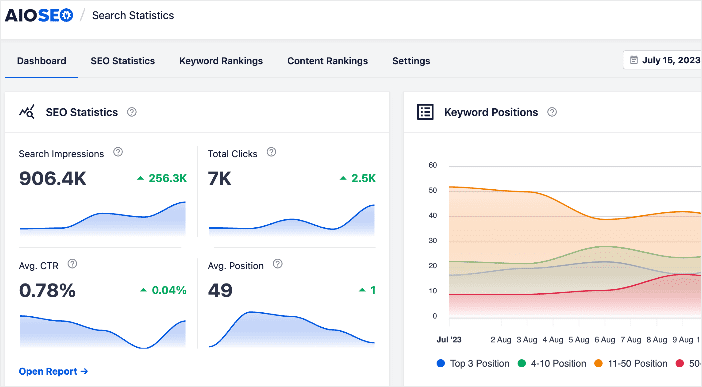
You can also use Search Statistics to help you achieve your SEO goals.
SEO Goals: 5 Examples and How to Achieve Them
Now that you know how to set common-sense SEO goals, let’s quickly look at some of the common ones you can set for your business. We’ll also look at some tips for achieving them.
1. Boost Brand Awareness
Brand awareness refers to the extent to which your target audience is familiar with your brand or products. It’s essential in gaining user trust and results in increased sales. SEO is a fantastic way of boosting brand awareness. Here’s an example of an SEO goal that helps you do this:
Achieve first-page ranking for [keyword] within 12 months
Besides checking your position on SERPs, you can also measure this goal by the month-on-month (MoM) increase in Search Impressions.
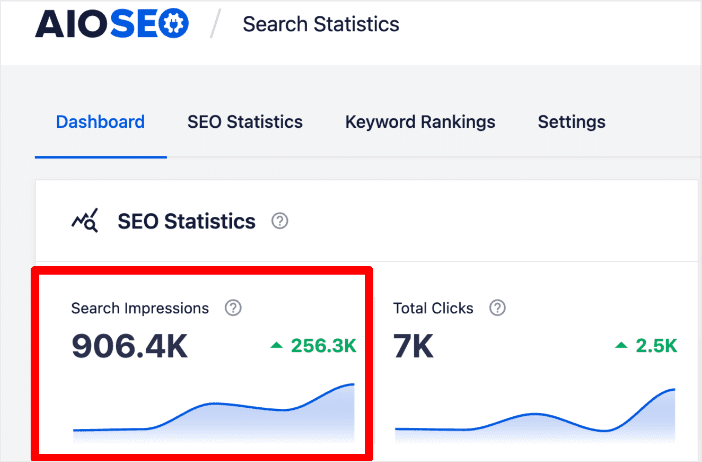
Search Impressions measure the number of times your search listing is seen on SERPs. An increase indicates that more people are noticing your content. It also shows that your listing is rising up in rankings.
2. Increase Organic Traffic
One of the most common SEO goals is increasing organic traffic to your site. Remember, your goals must be S.M.A.R.T, so just saying you want to increase organic traffic won’t cut it. You should also state how much traffic increase you want and specify the time frame. Here’s an example:
Increase organic traffic by 20% in 4 months
How can you do that?
Here are a few manageable goals you can set to help you achieve that:
- Publish X optimized pieces of content every month
- Build X backlinks on reputable publications
- Share each post X times on social media every week
3. Increase Organic Clickthrough Rate (CTR)
Another SEO goal you can set is increasing your clickthrough rates (CTRs). CTR refers to the percentage of people who click on your search listing on SERPs.
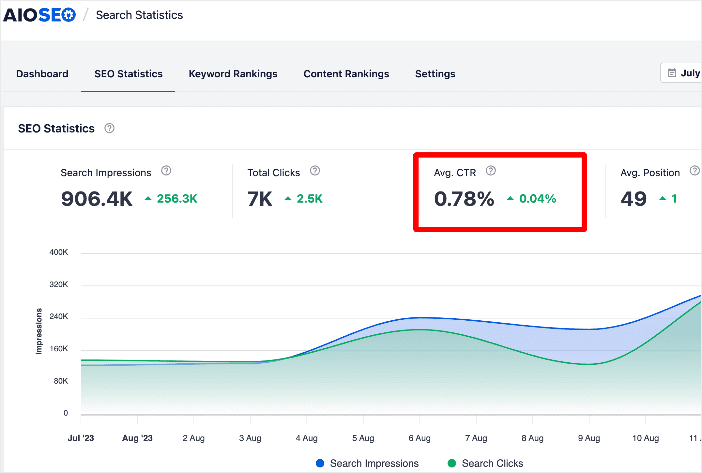
So what would this SEO goal look like?
Increase organic CTR by 5% in 3 months
A few tips to help you achieve this goal include:
- Optimize your SERP snippets
- Craft click-worthy SEO titles
- Enhance your search snippets with jump links
For more tips on reaching your goal to increase your CTR, check out this guide.
4. Decrease Your Bounce Rate
Bounce rate is the percentage of site visitors who leave after viewing one page rather than continuing to view other pages on your site. A high bounce rate indicates your website design or content doesn’t meet users’ needs. As a result, you lose out on valuable traffic.
Here are some examples of how you would set a goal to decrease the bounce rate:
Reduce bounce rate by 15% in 5 months
Reduce bounce rate to 55% in 6 months
Some tips for reducing your bounce rate include:
- Improving your page load speed
- A user-friendly site design
- Content that meets search intent
- Strategic internal linking
- Find out what users want
A lower bounce rate means people are consuming your content. This results in improved sales and newsletter subscriptions. It also leads to more returning visitors, an important element in building an engaged audience.
5. Increase Your Revenue
The ultimate business goal of SEO is to drive revenue. After all, as a marketing channel, you want your SEO strategy to help you generate leads and increase your customer base. Here’s a hypothetical example of an SEO goal that directly impacts your revenue:
Increase revenue by 10% in the next three months
A few ways you can use SEO to help you achieve this include:
- Create bottom-of-the-funnel (BoFu) content
- Leverage SEO reputation management to build authority and gain trust
- Maximize your local SEO
SEO Goals: Your FAQs Answered
What are SEO goals?
SEO goals refer to the specific objectives and outcomes a website or online business aims to achieve through search engine optimization (SEO) efforts. These goals are typically aligned with improving the website’s visibility, organic traffic, and overall performance on search engine results pages (SERPs).
Why are SEO goals important?
Setting clear SEO goals helps provide direction and focus to your optimization efforts. Without well-defined goals, it’s challenging to measure the effectiveness of your strategies and determine whether your SEO efforts are producing desired results.
How do I measure the success of my SEO goals?
If you’re a WordPress user, tools like All In One SEO (AIOSEO) can help you measure key performance indicators (KPIs) that help you track the success of your SEO goals.
Setting SEO Goals is Critical to Your Success
SEO is a powerful channel that can help you grow your business and increase revenue, especially if you set the right SEO goals. Unfortunately, many small business owners never set goals for their campaigns, resulting in them not getting the desired results.
We hope this article has helped you learn how to set common-sense SEO goals. You can also check out other articles on our blog, like our guide to spotting and stopping content decay or our tutorial on monitoring the impact of Google algorithm updates.
If you found this article helpful, please subscribe to our YouTube Channel. You’ll find many more helpful tutorials there. You can also follow us on Twitter, LinkedIn, or Facebook to stay in the loop.
Disclosure: Our content is reader-supported. This means if you click on some of our links, then we may earn a commission. We only recommend products that we believe will add value to our readers.
